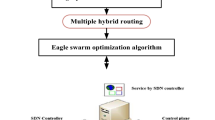Abstract
The opportunistic networks are a subclass of delay-tolerant networks where communication opportunities (contacts) are intermittent and there is no need to establish an end-to-end link between the communication nodes. The internet of things (IoT) present the notion of large networks of connected devices, sharing data about their environments and creating a diverse ecosystem of sensors, actuators, and computing nodes. IoT networks are a departure from traditional enterprise networks in terms of their scale and consist of heterogeneous collections of resource constrained nodes that closely interact with their environment. There are different issues for these networks. One of them is the selection of IoT devices in order to carry out a task in opportunistic networks. In this work, we implement and compare two fuzzy-based systems (FBS1 and FBS2) for IoT device selection in opportunistic networks. For FBS1, we use three input parameters: IoT device storage (IDST), IoT device waiting time (IDWT) and IoT device remaining energy (IDRE). The output parameter is IoT device selection decision (IDSD). For FBS2, we consider four input parameters adding IoT device security (IDSC) as a new parameter. Comparing complexity of FBS1 and FBS2, the FBS2 is more complex than FBS1. But, the FBS2 is more flexible and makes a better selection of IoT devices than FBS1.









Similar content being viewed by others
References
Akbas M, Turgut D (2011) Apawsan: actor positioning for aerial wireless sensor and actor networks. In: IEEE 36th conference on local computer networks (LCN-2011), pp 563–570
Akbas M, Brust M, Turgut D (2010) Local positioning for environmental monitoring in wireless sensor and actor networks. In: IEEE 35th conference on local computer networks (LCN-2010), pp 806–813
Elmazi D, Kulla E, Oda T, Spaho E, Sakamoto S, Barolli L (2015) A comparison study of two fuzzy-based systems for selection of actor node in wireless sensor actor networks. J Ambient Intell Humaniz Comput 6(5):635–645
Grabisch M (1996) The application of fuzzy integrals in multicriteria decision making. Eur J Oper Res 89(3):445–456
Huang C-M, Lan K-C, Tsai C-Z (2008) A survey of opportunistic networks. In: 22nd international conference on advanced information networking and applications—workshops (AINA-2008), pp 1672–1677
Inaba T, Elmazi D, Liu Y, Sakamoto S, Barolli L, Uchida K (2015) Integrating wireless cellular and ad-hoc networks using fuzzy logic considering node mobility and security. In: The 29th IEEE international conference on advanced information networking and applications workshops (WAINA-2015), pp 54–60
Inaba T, Sakamoto S, Kolici V, Mino G, Barolli L (2014a) A CAC scheme based on fuzzy logic for cellular networks considering security and priority parameters. In: The 9-th international conference on broadband and wireless computing, communication and applications (BWCCA-2014), pp 340–346
Inaba T, Sakamoto S, Kulla E, Caballe S, Ikeda M, Barolli L (2014b) An integrated system for wireless cellular and ad-hoc networks using fuzzy logic. In: International conference on intelligent networking and collaborative systems (INCoS-2014), pp 157–162
Iqbal H, Ma J, Mu Q, Ramaswamy V, Raymond G, Vivanco D, Zuena J (2017) Augmenting security of internet-of-things using programmable network-centric approaches: a position paper. In: 26th international conference on computer communication and networks (ICCCN-2017), pp 1–6
Kolici V, Inaba T, Lala A, Mino G, Sakamoto S, Barolli L (2014) A fuzzy-based CAC scheme for cellular networks considering security. In: International conference on network-based information systems (NBiS-2014), pp 368–373
Kulla E, Mino G, Sakamoto S, Ikeda M, Caballé S, Barolli L (2014) FBMIS: a fuzzy-based multi-interface system for cellular and ad hoc networks. In: International conference on advanced information networking and applications (AINA-2014), pp 180–185
Liu Y, Sakamoto S, Matsuo K, Ikeda M, Barolli L, Xhafa F (2015) A comparison study for two fuzzy-based systems: improving reliability and security of JXTA-overlay P2P platform. Soft Comput 20(7):2677–2687
Matsuo K, Elmazi D, Liu Y, Sakamoto S, Barolli L (2015a) A multi-modal simulation system for wireless sensor networks: a comparison study considering stationary and mobile sink and event. J Ambient Intell Humaniz Comput 6(4):519–529
Matsuo K, Elmazi D, Liu Y, Sakamoto S, Mino G, Barolli L (2015b) FACS-MP: a fuzzy admission control system with many priorities for wireless cellular networks and its perforemance evaluation. J High Speed Netw 21(1):1–14
Melodia T, Pompili D, Gungor V, Akyildiz I (2007) Communication and coordination in wireless sensor and actor networks. IEEE Trans Mob Comput 6(10):1126–1129
Mendel JM (1995) Fuzzy logic systems for engineering: a tutorial. Proc IEEE 83(3):345–377
Spaho E, Sakamoto S, Barolli L, Xhafa F, Ikeda M (2014) Trustworthiness in P2P: performance behaviour of two fuzzy-based systems for JXTA-overlay platform. Soft Comput 18(9):1783–1793
Spaho E, Sakamoto S, Barolli L, Xhafa F, Barolli V, Iwashige J (2013) A fuzzy-based system for peer reliability in JXTA-overlay P2P considering number of interactions. In: The 16th international conference on network-based information systems (NBiS-2013), pp 156–161
Xu G, Zhang M, Jin H-h, Wang Y (2017) Research on the topological evolution of uncertain social relations in opportunistic networks. In: IEEE international conference on edge computing (EDGE-2017), pp 202–205
Zadeh L (1994) Fuzzy logic, neural networks, and soft computing. Commun ACM 37(3):77–84
Author information
Authors and Affiliations
Corresponding author
Rights and permissions
About this article
Cite this article
Cuka, M., Elmazi, D., Bylykbashi, K. et al. Implementation and performance evaluation of two fuzzy-based systems for selection of IoT devices in opportunistic networks. J Ambient Intell Human Comput 10, 519–529 (2019). https://doi.org/10.1007/s12652-017-0676-0
Received:
Accepted:
Published:
Issue Date:
DOI: https://doi.org/10.1007/s12652-017-0676-0




